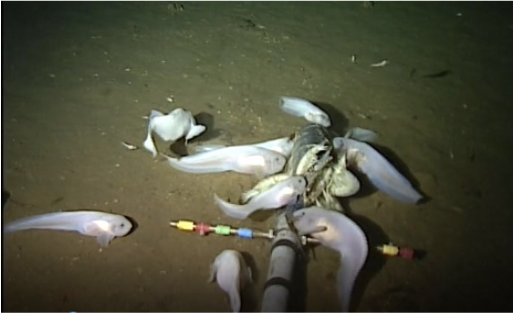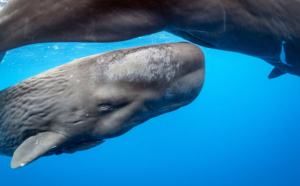A new snailfish was recently discovered deep in the Mariana Trench
East of Asia, the Mariana Trench is located in the South Pacific Ocean (1). At 36,201 feet deep, or almost seven miles, the trench is not only the deepest part of the ocean, but the deepest location on Earth (1). Five miles deep in the Mariana Trench, one could spot a Pseudoliparis swirei, more commonly known as the Mariana snailfish (2). While the size of a Mariana snailfish is very small (about the length of two soda cans), it can tolerate the pressure of more than 1600 elephants on its head (2). Their appearance is compared to that of ghosts, as they do not have a very strong-looking bone structure and their color is a clear pink and white (4). Scientists first discovered the fish in 2014 (2). An officer named this snailfish on the HMS Challenger, the British expedition that first discovered the trench in the 1870s (2). Officer Herbert Swire, a navigational sub-lieutenant, kept journals from their trip that were eventually published (2).

The Mariana Trench is known for being a difficult place for organisms to survive, since the pressure is more than most organisms can withstand (2). Furthermore, the darkness and cold temperature make the deepest sections almost uninhabiltable for any living organism (3). Researchers have found that the Mariana snailfish’s cartilage skeleton makes the fish more suitable for high pressure, as opposed to a bone skeleton (3). Scientists believe this may be the deepest fish they ever will find, even though there are another two miles before the bottom of the ocean is reached (2). Nevertheless, many animals are able to survive in the shallower parts of the trench, including shrimp and sea cucumbers (2). Of all the living creatures, snailfish are known to be one of the top predators (3). The snailfish feasts on tiny crustaceans the size and shape of a roly-poly pill bug (2).

In order to study the habits of this species in depth, researchers utilized new technology. A remotely controlled underwater vehicle was sent to the bottom of the trench, bringing back specimens for researchers. Once these specimens were brought to the labs researchers sequenced the fish’s genetics. They noted that some genome coding for vision was present, making it a possibility for the snailfish to see. Additionally, scientists concluded that the fish are able to stay flexible due to fatty acids that the fish produce (3). Although scientists have confirmed another species of snailfish that was caught on film near the Mariana snailfish, researchers still have more to explore with both the Mariana snailfish and the Mariana Trench (2).
Bibliography
- Friedman, N. (n.d.)The Mariana Trench: Earth’s Deepest Place. National Geographic. Retrieved from
www.nationalgeographic.org/activity/mariana-trench-deepest-place-earth/ - Welch, C. (2017, November 29). New Fish Species Lives 5 Miles Underwater- a Record. National Geographic. Retrieved from
https://www.nationalgeographic.com/science/article/deepest-sea-fish-identified-snailfish-pseudoliparis-swirei-spd - Yirka, B. (2019, April 16). Sequencing of snailfish from Mariana Trench reveals clues on how it adapted to live in such deep water. Phys. Retrieved from
https://phys.org/news/2019-04-sequencing-snailfish-mariana-trench-reveals.html - Boyle, A. (2017, November 28). Meet the deepest fish in the sea: The Mariana snailfish, identified with UW’s help. GeekWire. Retrieved from
https://www.geekwire.com/2017/meet-deepest-fish-sea-mariana-snailfish-identified-uws-help/






Comments are closed.